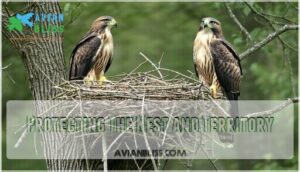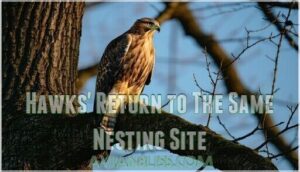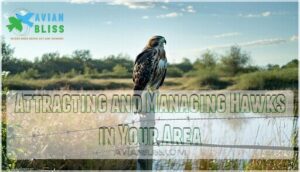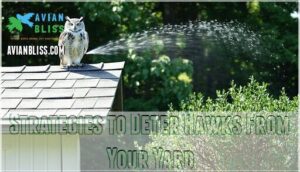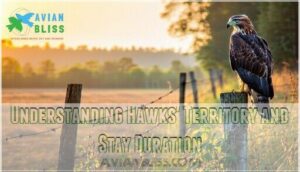This site is supported by our readers. We may earn a commission, at no cost to you, if you purchase through links.
 Hawks typically stick around one area for 2-6 months during breeding season, though it depends on whether you’re dealing with year-round residents or seasonal migrants.
Hawks typically stick around one area for 2-6 months during breeding season, though it depends on whether you’re dealing with year-round residents or seasonal migrants.
Resident species like Red-tailed Hawks often claim the same hunting grounds for years, while migratory hawks treat your neighborhood more like a temporary lease.
During nesting season from March to July, mated pairs become fiercely territorial, rarely venturing beyond a mile from their nest.
Food availability acts as the ultimate dealbreaker – abundant prey keeps them put, while scarce hunting forces them to pack up and relocate.
Understanding their territorial patterns reveals fascinating insights about their hunting strategies.
Table Of Contents
- Key Takeaways
- Factors Influencing Hawk Stay Duration
- Hawk Stay Duration During Hunting
- Hawk Stay Duration During Nesting
- Hawk Stay Duration and Migration
- Hawks’ Return to The Same Nesting Site
- Attracting and Managing Hawks in Your Area
- Strategies to Deter Hawks From Your Yard
- Understanding Hawks’ Territory and Stay Duration
- Frequently Asked Questions (FAQs)
- Do hawks stay in the same area?
- How long do hawks stay in a nest?
- How long can a hawk stay in one place?
- Do hawks leave for a long time?
- Do hawks reside in one place year-round?
- How long can a hawk fly without rest?
- How long do hawks stay in the same area?
- What does it mean when a hawk hangs around your yard?
- Why does a hawk stay around my house?
- What to do if you have a hawk in your yard?
- Conclusion
Key Takeaways
- You’ll find hawks typically stay in one area for 2-6 months during breeding season, though resident species like Red-tailed Hawks often claim the same hunting grounds for years while migratory hawks treat your neighborhood like a temporary lease.
- Food availability acts as the ultimate dealbreaker – when prey is abundant, hawks commit to territories for extended periods, but scarce hunting forces them to relocate, with hawks needing 10-15% of their body weight in prey daily.
- During nesting season from March to July, mated pairs become fiercely territorial and won’t venture beyond a mile from their nest, showing remarkable site fidelity by returning to the same nesting locations year after year.
- You can influence how long hawks stay by either attracting them with bird feeders, water sources, and tall perching trees, or deterring them by removing food sources, eliminating roosting spots, and using owl decoys or motion-activated sprinklers.
Factors Influencing Hawk Stay Duration
When you’re wondering how long hawks will stick around your area, you’ll find that several key factors determine their stay duration.
Food availability, suitable nesting sites, environmental conditions, and human interference all work together to influence whether these skilled raptors will remain in one territory for weeks, months, or even years.
This combination of factors ultimately decides the length of time hawks will stay in a given area.
Food Availability
Food availability acts as the cornerstone determining how long hawks establish residence in any given area.
Food is everything to a hawk—it’s their mortgage payment, their reason to stay, and their ticket out of town.
When prey abundance meets their daily nutritional demands, hawks commit to territories for extended periods, sometimes occupying the same hunting grounds for entire seasonal cycles.
Your local hawk population directly reflects the health of small mammal and bird communities nearby.
Hunting success rates dramatically influence hawk territory size and home range boundaries.
Well-fed raptors maintain smaller territories, while those facing food scarcity expand their hunting grounds or abandon areas altogether.
Hawks require consistent protein sources to support breeding, nesting, and raising young successfully.
As territorial animals, hawks defend their territory from intruders.
Here’s what drives hawk stay duration through food dynamics:
- Daily consumption needs – Hawks need 10-15% of their body weight in prey daily
- Prey population cycles – Seasonal variation affects rodent and bird availability
- Diet adaptations – Urban hawks adjust feeding strategies for city environments
- Hunting efficiency – Multiple vantage points improve predation success rates
- Resource depletion – Overuse triggers territorial relocation patterns
Nesting Sites and Territory
Once hawks find prime real estate, they’re not going anywhere.
Nest fidelity drives these raptors to return annually, sometimes for decades.
Territory defense becomes their full-time job, with aggressive attacks on intruders.
Site selection focuses on tall trees near hunting grounds.
Urban nesting has increased as cities offer abundant prey and sturdy buildings for hawk nesting habits.
Environmental Conditions
Ever wonder why that hawk disappeared after last week’s storm?
Environmental conditions dramatically shape hawk stay duration through complex ecological interactions.
Climate impact, weather patterns, and habitat loss create cascading effects on prey abundance, forcing territorial adjustments.
Broad-winged hawks, for example, face population declines linked to habitat alterations.
Five key environmental factors influence hawk behavior:
- Temperature extremes affecting prey activity levels
- Seasonal vegetation cycles impacting hunting success
- Pollution effects reducing ecosystem biodiversity
- Microclimate variations creating resource zones
- Extreme weather disrupting territorial patterns
These hawk environmental conditions determine stay duration.
Human Interference
When people disrupt hawk habitats through excessive noise, construction, or nest disturbance, these raptors quickly relocate to safer territories.
Your deterrent methods and habitat disruption efforts can reduce hawk stay duration substantially.
However, thoughtful habitat management allows coexistence—hawks respect boundaries when you minimize food reduction strategies near their nests while maintaining human safety through respectful distance, which enables coexistence and ensures human safety.
Hawk Stay Duration During Hunting
When you’re watching a hawk hunt, you’ll notice they can perch in the same spot for up to six hours, patiently waiting for the perfect moment to strike.
Their hunting strategy involves moving through different sections of their territory and using energy-efficient circling patterns to spot prey from great distances.
Hunting Behavior and Techniques
Understanding what drives a hawk’s territorial choices reveals fascinating hunting behavior patterns that showcase nature’s precision engineering.
Hawks master the art of prey selection through methodical observation and lightning-fast execution. Their hunting techniques demonstrate remarkable adaptability across different environments and seasons.
Key hunting strategies include:
- Stalking patience – remaining motionless for hours while scanning territory size up to two miles
- Strategic positioning – selecting perches that maximize visibility of food sources below
- Hunting speed – diving at prey with talons extended at approximately 30 miles per hour
- Seasonal diet adaptation – adjusting hunting behavior based on available prey throughout the year
These predators combine sharp eyesight with calculated patience, often perching in the same strategic locations for extended periods.
Hawks, like other birds, may also exhibit mobbing defense tactics against larger predators. Their hunting behavior revolves around energy conservation, making every strike count when targeting rodents, songbirds, and small mammals within their established territory.
Energy Conservation Through Circling
When you see a hawk gliding in wide circles overhead, it’s not just a graceful display—it’s a masterclass in energy conservation.
Hawks use rising thermals, or warm air currents, to gain altitude effortlessly, allowing them to stay aloft for hours without tiring. This circling efficiency gives them a sharp predatory advantage, letting them scan vast areas for prey while barely flapping their wings.
- Thermal usage helps hawks conserve energy while maintaining high altitudes.
- Speed variation during circling allows precise adjustments for better prey spotting.
- Predatory advantage comes from their ability to remain airborne and patient.
By riding thermals and perfecting their hawk circling techniques, these birds thrive in their habitats, conserving energy for the perfect strike when prey is spotted.
Hawk Stay Duration During Nesting
When you’re watching hawks during nesting season, you’ll notice they become much more committed to staying in one specific area for extended periods.
During this critical time, which typically lasts 2-4 months, hawks won’t venture far from their chosen nest site, as they’re focused on protecting their eggs, raising their young, and defending their territory from intruders.
Nesting Habits and Nest Site Selection
Hawks pick nesting sites like seasoned real estate agents—location is everything.
You’ll find them scouting tall trees, cliff faces, and even urban structures that offer the perfect blend of security and hunting access.
Nest construction involves gathering sticks, twigs, and soft materials like moss or bark strips.
Many species show remarkable site fidelity, returning to the same general area year after year.
Red-tailed hawks prefer forest edges, while Cooper’s hawks favor dense woodland canopies.
Harris’s hawks often choose saguaro cacti in desert regions.
The key factors driving their hawk nesting sites include protection from predators, proximity to abundant prey, and minimal human disturbance during their sensitive breeding season.
Protecting The Nest and Territory
A hawk’s territorial behavior becomes fierce during breeding season, with pairs aggressively defending their hawk breeding territory from predators and intruders.
Their territoriality extends beyond the immediate nest, creating buffer zones that guarantee habitat protection.
Predator threats like owls trigger intense nest defense responses, while human impact can force hawks to abandon otherwise perfect nesting sites, affecting their hawk area fidelity and overall well-being due to territorial behavior.
Hawk Stay Duration and Migration
You’ll find that migration patterns vary dramatically among hawk species, with some traveling thousands of miles seasonally while others never leave their established territories.
Understanding whether you’re observing a year-round resident or a temporary visitor depends on factors like food availability, weather conditions, and the specific hawk species in your area.
Migratory and Non-Migratory Hawks
Throughout North America, you’ll encounter hawks that follow dramatically different lifestyle patterns in terms of seasonal movements. Migration Triggers vary substantially between species, creating distinct categories of hawk behavior.
Resident Hawks like Harris’s Hawks and many Red-tailed Hawks demonstrate strong Habitat Fidelity, staying put year-round in their established territories. These nonmigrant species have adapted to survive local winter conditions without needing to relocate.
However, hawk migration patterns reveal fascinating complexity:
- Complete migrants – Sharp-shinned and Broad-winged Hawks travel thousands of miles to reach Wintering Grounds
- Partial migrants – Some Red-tailed Hawk populations migrate while others remain resident
- Altitudinal migrants – Mountain hawks simply move to lower elevations
- Nomadic species – Northern Goshawks wander based on prey availability
Understanding these hawk seasonal movements helps explain why you might see different species throughout the year. The hawk residency period depends entirely on whether you’re observing partial migrants or true residents in your area.
Reasons for Migration
Understanding what drives hawk migration reveals fascinating patterns in their territorial behavior.
Food scarcity stands as the primary migration trigger, pushing hawks southward when prey becomes scarce during harsh winters.
You’ll notice hawk seasonal movements intensify when weather conditions make hunting nearly impossible in northern territories.
Mating opportunities also influence these remarkable journeys, with young hawks often migrating to find partners outside their birth territories.
While established pairs might relocate if one mate dies, nesting locations play a vital role too – when preferred sites become unavailable due to habitat changes or human development, hawks must seek new breeding grounds.
Hawk migration patterns vary dramatically between species, with some responding immediately to food availability drops, while others follow predictable seasonal schedules.
These migration triggers guarantee survival by directing hawks toward regions offering better hunting prospects, suitable mates, and secure nesting locations for successful reproduction, ensuring the continuation of their species through successful reproduction.
Hawks’ Return to The Same Nesting Site
You’ll find that most hawks return to the same nesting site year after year, like a familiar neighborhood where they know all the best spots.
This behavior, called nest site fidelity, happens because successful nesting locations provide the safety and resources these birds need to raise their young effectively, which is a result of complete concepts such as knowing the area.
Species-Specific Nesting Behavior
Different hawk species follow distinct patterns regarding nesting habits, and you’ll notice these behaviors if you observe them closely. Each species has evolved unique approaches to nest construction and site selection based on their social structures and environmental needs.
Red-tailed hawks demonstrate remarkable nest fidelity, with monogamous pairs returning to the same sturdy platform year after year. They’ll repair and expand their existing nest rather than starting fresh. Cooper’s hawks take a different approach, building new nests annually despite staying in familiar territories. These species-specific behaviors reflect their hunting strategies and social structures.
Here’s how different hawk species handle nesting:
- Harris’s hawks practice social nesting, with extended family groups sharing territories
- Red-tailed hawks show strong nest reuse patterns with their lifelong partners
- Cooper’s hawks prefer fresh nest construction each breeding season
- Sharp-shinned hawks build compact nests in dense forest cover
- Broad-winged hawks select sites based on forest density and prey availability
Understanding these species-specific behaviors helps explain why certain hawks stay longer in your area.
Nest Site Familiarity and Safety
Once established, hawks demonstrate remarkable site fidelity, returning to proven nesting locations with unwavering loyalty.
You’ll notice they choose these spots based on safety factors like elevation, sturdy construction, and previous breeding success.
This nest reuse behavior stems from their intimate knowledge of the territory—they know every branch, wind pattern, and escape route.
Hawks invest heavily in nest defense, viewing familiar sites as extensions of their territorial behavior.
Their hawk home range often centers around these ancestral nesting sites, where generations have thrived.
However, nest threats can disrupt this pattern entirely, such as human interference, habitat destruction, or predator pressure forces them to abandon even beloved locations.
When you observe hawk territorial defense, you’re witnessing their commitment to maintaining these safe havens.
The familiarity breeds confidence—they understand the hawk nest site familiarity provides strategic advantages for raising young and monitoring their domain.
Attracting and Managing Hawks in Your Area
You can encourage hawks to stay in your area by providing the right combination of food sources, water, and suitable perching spots that meet their hunting and nesting needs.
Creating a natural-looking habitat with minimal human interference gives these impressive raptors the comfortable environment they need to establish territory and remain for extended periods, allowing them to thrive in a comfortable setting.
Providing Food, Water, and Shelter
Bird feeders indirectly boost hawk stay duration by attracting prey like finches and sparrows.
You’ll need water sources such as bird baths for drinking and cooling. Shelter types include dense shrubs and tall trees offering perch availability.
Natural yards with minimal pruning create ideal hawk food sources while bird feeding stations concentrate potential meals, making your property irresistible to these magnificent raptors.
Supplementing their diet with prey attractant products can further encourage hawks to remain, utilizing prey attractant products and creating an environment that supports their presence, with magnificent raptors as the target visitors.
Creating Native-Looking Habitat
Beyond providing food and water, transforming your yard into native habitat creates the perfect hawk territory. Hawks prefer landscapes that mirror their natural hawk habitat preferences, where prey thrives and perching spots abound.
Native Plantings form the foundation of successful hawk habitat range expansion.
- Plant native trees like oaks and pines for nesting platforms and Perch Availability
- Add berry-producing shrubs that attract songbirds as natural prey sources
- Establish native wildflowers and grasses for ground cover and seed production
- Practice Minimal Pruning to maintain natural-looking vegetation density
- Create Water Sources through shallow basins for drinking and bathing needs
This approach supports hawk local movements while enhancing Shelter Creation opportunities.
To further attract birds, consider adding a birdbath with fresh water.
Minimizing Human Interference
Hawks value quiet spaces more than you might expect.
Keep your distance from active nests—at least 100 yards during breeding season—to avoid triggering aggressive hawk territorial behavior.
Loud construction, lawn mowing, or parties near nesting areas can force hawks to abandon their territory entirely.
Responsible landscaping means timing major yard work outside nesting periods.
Reducing poisons in your garden protects both hawks and their prey.
Safe deterrents work better than harassment for ethical coexistence.
Remember, respecting their space actually increases your chances of observing these magnificent hunters long-term.
Strategies to Deter Hawks From Your Yard
If you’re tired of hawks treating your backyard like their personal hunting ground, you can take several practical steps to encourage them to relocate.
By removing food sources, eliminating perching spots, and installing deterrents like owl decoys or motion-activated sprinklers, you’ll make your yard less appealing to these persistent predators.
You will be taking steps to make your yard less hospitable by using methods such as removing attractants and utilizing deterrents.
Implementing Hawk Deterrents
Once you’ve created an inviting habitat, you might find yourself needing to dial back hawk activity when they become too comfortable around your property.
Strategic hawk deterrence requires understanding hawk behavior and implementing multiple approaches that disrupt their comfort zone.
Effective hawk deterrents work by targeting their hunting patterns and territorial instincts:
- Decoy Effectiveness – Position large owl statues around your yard, as owls naturally threaten hawks and trigger avoidance responses
- Netting Solutions – Install anti-hawk netting over chicken coops and small animal areas to prevent swooping attacks
- Noise Deterrents – Use motion-activated sprinklers and wind chimes to create unpredictable sounds that startle approaching hawks
- Vantage Removal – Cut back tree branches and eliminate high perching spots where hawks scout for prey
- Stringing Lines – Run fishing line or wire across open areas to confuse hawks during flight approaches
Rotate these hawk deterrents regularly to prevent habituation. Hawks adapt quickly to static deterrence methods, so varying your approach maintains effectiveness against persistent hawk human interference.
Consider browsing for effective yard products to enhance your strategy.
Minimizing Food Sources and Roosting Areas
While deterrents create barriers, controlling what attracts hawks proves equally effective. You’ll want to focus on removing the buffet that keeps these raptors hanging around your property.
Start by securing chickens in covered runs and reducing rodents through proper waste management. Clean up fallen fruit from trees, cover compost piles, and remove outdoor pet food bowls after feeding time.
Bird feeder shielding prevents hawks from spotting easy prey below. Many homeowners also utilize various yard products to discourage hawks.
Food Management Roosting Strategies
Remove perches by pruning overhanging branches and installing roosting spikes on fence posts. Anti-hawk netting over vulnerable areas eliminates access points.
These habitat modifications reduce food availability and comfortable roosting spots, encouraging hawks to hunt elsewhere.
Understanding Hawks’ Territory and Stay Duration
You’ll find that hawks don’t just randomly wander from place to place, but instead establish territories they defend fiercely, much like your neighbor who puts up a fence around their prized garden.
Understanding how long these raptors stay in one area depends on several key factors, including food availability, nesting success, and whether they’re migratory or year-round residents, which can influence their decision to stay or leave a particular area.
Territorial Behavior and Defense
When you observe a hawk’s fierce territorial behavior, you’re witnessing nature’s ultimate property protection system.
These raptors establish strict boundaries around their territory size, using aggressive defense mechanisms to ward off intruders. Hawks demonstrate remarkable intraspecific aggression when competing with their own species, while interspecific competition drives conflicts with other bird species over prime real estate.
Their territorial behavior centers on three key defense strategies:
- Aerial displays – Soaring high to assert dominance over their domain
- Vocal warnings – Sharp screeches that communicate ownership
- Physical confrontation – Direct attacks on trespassers
Through resource control, hawks maintain exclusive access to hunting grounds that determine their stay duration in any given area.
Factors Influencing Stay Duration and Movements
Several key factors determine hawk stay duration in any given area, and understanding these can help you predict their movements.
Prey abundance tops the list – when rodents, birds, and insects are plentiful, hawks won’t budge from their prime real estate.
Weather patterns also play a major role, as harsh winters or prolonged droughts force relocation.
Habitat quality matters too; dense forests with tall perches beat sparse scrubland every time.
Mating success influences long-term residence, with successful pairs showing strong nest site familiarity.
Human development disrupts established territories, pushing hawks to seek new hawk foraging range.
These factors interact to shape hawk migration patterns and hawk dispersal distance, creating a complex web of influences that determine whether your local hawk stays put or moves on.
Seasonal changes act as reliable migratory cues, influencing when hawks might move on.
Frequently Asked Questions (FAQs)
Do hawks stay in the same area?
Like faithful guardians of their kingdom, hawks typically stick to the same territory year after year.
You’ll find them defending their hunting grounds and nesting sites with remarkable loyalty, unless forced to relocate by threats.
How long do hawks stay in a nest?
Hawks don’t actually live in their nests year-round. You’ll find they only occupy nests during breeding season, typically 2-4 months from spring through early summer while raising their young chicks.
How long can a hawk stay in one place?
Ever wonder why you’ll spot the same hawk perched motionless for hours?
They’re master hunters who’ll stay put for up to six hours, patiently stalking prey with laser focus until the perfect strike opportunity presents itself.
Do hawks leave for a long time?
Migration patterns vary by species and circumstances.
Some hawks migrate seasonally for hundreds of miles, staying away for months.
Others remain year-round residents, only leaving briefly when food becomes scarce or territories are threatened.
Do hawks reside in one place year-round?
Some hawk species stay put year-round if you’ve got good food sources and mild weather in your area.
Others migrate seasonally, but they’ll return to the same territory annually unless something forces them out.
How long can a hawk fly without rest?
You’ll find these raptors can soar for hours without landing, using thermal currents to conserve energy. They’re built for endurance, gliding effortlessly while hunting, though they’ll eventually need rest.
How long do hawks stay in the same area?
You’ll find hawks typically stay in their territory year-round if food’s abundant and conditions remain favorable.
They’ll only relocate when hunting becomes unsuccessful, nests get damaged, or predators threaten their safety.
What does it mean when a hawk hangs around your yard?
When a hawk lingers in your yard, it’s likely scouting for food like rodents or small birds.
It might also find the area safe for nesting or perching—nature’s way of saying your yard’s appealing!
Why does a hawk stay around my house?
Perching persistently around your property, hawks stay because you’ve got abundant food sources like rodents, small birds, or insects.
They’re also likely nesting nearby in tall trees, using your yard as prime hunting territory.
What to do if you have a hawk in your yard?
If a hawk’s in your yard, secure pets, shield bird feeders, and remove food sources like rodents.
Try motion-activated sprinklers or owl decoys to deter them.
Remember, they’re harmless unless threatened—so no sudden moves, and always be aware of your surroundings to avoid threatening them.
Conclusion
Understanding how long hawks stay in one area is like solving a wildlife puzzle with multiple pieces.
These magnificent raptors typically remain in territories for 2-6 months during breeding season, though resident species may claim the same hunting grounds for years.
Food availability, nesting requirements, and seasonal patterns all influence their stay duration.
Whether you’re attracting hawks or deterring them, recognizing their territorial behavior helps you coexist with these powerful predators while respecting their natural hunting instincts.



